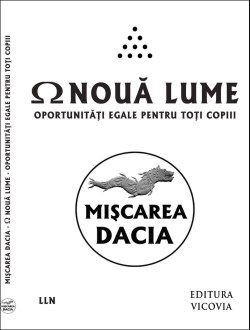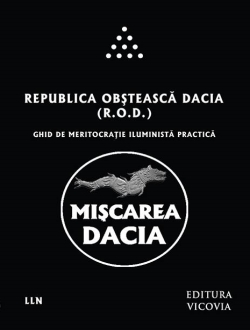 Vă invit să vă alăturaţi grupului Facebook Mişcarea DACIA, ce-şi propune un alt fel de a face politică!
Vă invit să vă alăturaţi grupului Facebook Mişcarea DACIA, ce-şi propune un alt fel de a face politică!Citiţi partea introductivă şi proiectul de Program, iar dacă vă place, veniţi cu noi !
O puteţi face clicând alături imaginea, sau acest link
Archive for the ‘Dacia Iluministă’ Category:
Hermeticism (4)
V. THE PRINCIPLE OF RHYTHM
“Everything flows, out and in; everything has its tides; all things rise and fall; the pendulum-swing manifests in everything; the measure of the swing to the right is the measure of the swing to the left; rhythm compensates.” –The Kybalion
This Principle embodies the truth that in everything there is manifested a measured motion, to and fro; a flow and inflow; a swing backward and forward; a pendulum-like movement; a tide-like ebb and flow; a high-tide and low-tide; between the two poles which exist in accordance with the Principle of Polarity described a moment ago. There is always an action and a reaction; an advance and a retreat; a rising and a sinking. This is in the affairs of the Universe, suns, worlds, men, animals, mind, energy, and matter. This law is manifest in the creation and destruction of worlds; in the rise and fall of nations; in the life of all things; and finally in the mental states of Man (and it is with this latter that the Hermetists find the understanding of the Principle most important). The Hermetists have grasped this Principle, finding its universal application, and have also discovered certain means to overcome its effects in themselves by the use of the appropriate formulas and methods.
They apply the Mental Law of Neutralization. They cannot annul the Principle, or cause it to cease its operation, but they have learned how to escape its effects upon themselves to a certain degree depending upon the Mastery of the Principle. They have learned how to USE it, instead of being USED BY it. In this and similar methods, consist the Art of the Hermetists. The Master of Hermetics polarizes himself at the point at which he desires to rest, and then neutralizes the Rhythmic swing of the pendulum which would tend to carry him to the other pole. All individuals who have attained any degree of Self-Mastery do this to a certain degree, more or less unconsciously, but the Master does this consciously, and by the use of his Will, and attains a degree of Poise and Mental Firmness almost impossible of belief on the part of the masses who are swung backward and forward like a pendulum. This Principle and that of Polarity have been closely studied by the Hermetists, and the methods of counteracting, neutralizing, and USING them form an important part of the Hermetic Mental Alchemy.
Excerpt from The Kybalion, Chapter 2, page 11
The Three Initiates
Artwork by Svetoslav Stoyanov

Tags: Hermeticism
Hermeticism (3)
IV. THE PRINCIPLE OF POLARITY
“Everything is Dual; everything has poles; everything has its pair of opposites; like and unlike are the same; opposites are identical in nature, but different in degree; extremes meet; all truths are but half-truths; all paradoxes may be reconciled.”–The Kybalion
This Principle embodies the truth that “everything is dual”; “everything has two poles”; “everything has its pair of opposites,” all of which were old Hermetic axioms. It explains the old paradoxes, that have perplexed so many, which have been stated as follows: “Thesis and antithesis are identical in nature, but different in degree”; “opposites are the same, differing only in degree”; “the pairs of opposites may be reconciled”; “extremes meet”; “everything is and isn’t, at the same time”; “all truths are but half-truths”; “every truth is half-false”; “there are two sides to everything,” etc., etc., etc.
It explains that in everything there are two poles, or opposite aspects, and that “opposites” are really only the two extremes of the same thing, with many varying degrees between them To illustrate: Heat and Cold, although “opposites,” are really the same thing, the differences consisting merely of degrees of the same thing. Look at your thermometer and see if you can discover where “heat” terminates and “cold” begins! There is no such thing as “absolute heat” or “absolute cold”–the two terms “heat” and “cold” simply indicate varying degrees of the same thing, and that “same thing” which manifests as “heat” and “cold” is merely a form, variety, and rate of Vibration. So “heat” and “cold” are simply the “two poles” of that which we call “Heat”–and the phenomena attendant thereupon are manifestations of the Principle of Polarity.
The same principle manifests in the case of “Light and Darkness,” which are the same thing, the difference consisting of varying degrees between the two poles of the phenomena. Where does “darkness” leave off, and “light” begin? What is the difference between “Large and Small”? Between “Hard and Soft”? Between “Black and White”? Between “Sharp and Dull”? Between “Noise and Quiet”? Between “High and Low”? Between “Positive and Negative”?
The Principle of Polarity explains these paradoxes, and no other Principle can supersede it. The same Principle operates on the Mental Plane. Let us take a radical and extreme example that of “Love and Hate,” two mental states apparently totally different. And yet there are degrees of Hate and degrees of Love, and a middle point in which we use the terms “Like or Dislike,” which shade into each other so gradually that sometimes we are at a loss to know whether we “like” or “dislike” or “neither.” And all are simply degrees of the same thing, as you will see if you will but think a moment. And, more than this (and considered of more importance by the Hermetists), it is possible to change the vibrations of Hate to the vibrations of Love, in one’s own mind, and in the minds of others.
Many of you, who read these lines, have had personal experiences of the involuntary rapid transition from Love to Hate, and the reverse, in your own case and that of others. And you will therefore realize the possibility of this being accomplished by the use of the Will, by means of the Hermetic formulas. “Good and Evil” are but the poles of the same thing, and the Hermetist understands the art of transmuting Evil into Good, by means of an application of the Principle of Polarity. In short, the “Art of Polarization” becomes a phase of “Mental Alchemy” known and practiced by the ancient and modern Hermetic Masters. An understanding of the Principle will enable one to change his own Polarity, as well as that of others, if he will devote the time and study necessary to master the art.
Excerpt from the Kybalion, Chapter 2, page 10
The Three Initiates
Artwork by Jaime Adrover

Tags: Hermeticism
Hermeticism (2)
II. THE PRINCIPLE OF CORRESPONDENCE
“As above, so below; as below, so above.”–The Kybalion
This Principle embodies the truth that there is always a Correspondence between the laws and phenomena of the various planes of Being and Life. The old Hermetic axiom ran in these words: “As above, so below; as below, so above.” And the grasping of this Principle gives one the means of solving many a dark paradox, and hidden secret of Nature. There are planes beyond our knowing, but when we apply the Principle of Correspondence to them we are able to understand much that would otherwise be unknowable to us. This Principle is of universal application and manifestation, on the various planes of the material, mental, and spiritual universe–it is an Universal Law. The ancient Hermetists considered this Principle as one of the most important mental instruments by which man was able to pry aside the obstacles which hid from view the Unknown. Its use even tore aside the Veil of Isis to the extent that a glimpse of the face of the goddess might be caught. Just as a knowledge of the Principles of Geometry enables man to measure distant suns and their movements, while seated in his observatory, so a knowledge of the Principle of Correspondence enables Man to reason intelligently from the Known to the Unknown. Studying the monad, he understands the archangel.
III. THE PRINCIPLE OF VIBRATION
“Nothing rests; everything moves; everything vibrates.”–The Kybalion
This Principle embodies the truth that “everything is in motion”; “everything vibrates”; “nothing is at rest”; facts which Modern Science endorses, and which each new scientific discovery tends to verify. And yet this Hermetic Principle was enunciated thousands of years ago, by the Masters of Ancient Egypt. This Principle explains that the differences between different manifestations of Matter, Energy, Mind, and even Spirit, result largely from varying rates of Vibration. From THE ALL, which is Pure Spirit, down to the grossest form of Matter, all is in vibration–the higher the vibration, the higher the position in the scale. The vibration of Spirit is at such an infinite rate of intensity and rapidity that it is practically at rest–just as a rapidly moving wheel seems to be motionless. And at the other end of the scale, there are gross forms of matter whose vibrations are so low as to seem at rest. Between these poles, there are millions upon millions of varying degrees of vibration. From corpuscle and electron, atom and molecule, to worlds and universes, everything is in vibratory motion. This is also true on the planes of energy and force (which are but varying degrees of vibration); and also on the mental planes (whose states depend upon vibrations); and even on to the spiritual planes. An understanding of this Principle, with the appropriate formulas, enables Hermetic students to control their own mental vibrations as well as those of others. The Masters also apply this Principle to the conquering of Natural phenomena, in various ways. “He who understands the Principle of Vibration, has grasped the sceptre of power,” says one of the old writers.
Excerpt of The Kybalion, chapter 2, page 9
The Three Initiates
Artwork by Imagicon Illustration

Tags: Hermeticism
Hermeticism (1)
The Seven Hermetic Principles
“The Principles of Truth are Seven; he who knows these, understandingly, possesses the Magic Key before whose touch all the Doors of the Temple fly open.”–The Kybalion
The Seven Hermetic Principles, upon which the entire Hermetic Philosophy is based, are as follows:
I. THE PRINCIPLE OF MENTALISM.
II. THE PRINCIPLE OF CORRESPONDENCE.
III. THE PRINCIPLE OF VIBRATION.
IV. THE PRINCIPLE OF POLARITY.
V. THE PRINCIPLE OF RHYTHM.
VI. THE PRINCIPLE OF CAUSE AND EFFECT.
VII. THE PRINCIPLE OF GENDER.
These Seven Principles will be discussed and explained as we proceed with these lessons. A short explanation of each, however, may as well be given at this point.
I. THE PRINCIPLE OF MENTALISM
“THE ALL is MIND; The Universe is Mental.”–The Kybalion
This Principle embodies the truth that “All is Mind.” It explains that THE ALL (which is the Substantial Reality underlying all the outward manifestations and appearances which we know under the terms of “The Material Universe”; the “Phenomena of Life”; “Matter”; “Energy”; and in short, all that is apparent to our material senses) is SPIRIT, which in itself is UNKNOWABLE and UNDEFINABLE, but which may be considered and thought of as AN UNIVERSAL, INFINITE, LIVING MIND. It also explains that all the phenomenal world or universe is simply a Mental Creation of THE ALL, subject to the Laws of Created Things, and that the universe, as a whole, and in its parts or units, has its existence in the Mind of THE ALL, in which Mind we “live and move and have our being.” This Principle, by establishing the Mental Nature of the Universe, easily explains all of the varied mental and psychic phenomena that occupy such a large portion of the public attention, and which, without such explanation, are non-understandable and defy scientific treatment. An understanding of this great Hermetic Principle of Mentalism enables the individual to readily grasp the laws of the Mental Universe, and to apply the same to his well-being and advancement. The Hermetic Student is enabled to apply intelligently the great Mental Laws, instead of using them in a haphazard manner. With the Master-Key in his possession, the student may unlock the many doors of the mental and psychic temple of knowledge, and enter the same freely and intelligently. This Principle explains the true nature of “Energy,” “Power,” and “Matter,” and why and how all these are subordinate to the Mastery of Mind.
Excerpt of The Kybalion, chapter 2, page 9
The Three Initiates
Artwork by Nan Deressa

Tags: Hermeticism
Hyperian History Of The World (17th Century, Part 3)
Noutăţi
Hyperian History Of The World (17th Century, Part 3)
The 17th Century also saw major developments in the arts. If the focus of the renaissance had been on the visual arts of painting and sculpture, matching and surpassing the visual style of ancient Greece and Rome, the 17th century saw truly innovative ideas in both Literature and Music.
Music had, of course, since prehistoric times, been used for both entertainment as well as for spiritual and religious purposes. Whilst all manner of folk traditions existed, featuring traditional instruments accompanying the singing of songs, the religious power of music had been recognised by the catholic church and, over the centuries, a kind of formalisation of music had occurred.
Catholic monks had begun singing excerpts of the bible using simple melodies. The singing was unaccompanied, as the human voice was considered the only pure instrument. Eventually, monks developed techniques of harmony and counterpoint to increase the complexity as well as the beauty of their singing. Crucially, a system had been developed where music could be written down and thus the same pieces could be performed by different musicians and preserved for ever. Eventually composers began to study music to high levels and produce beautiful works of polyphony, yet nearly always for religious purposes, such as musical settings of the catholic mass, always for unaccompanied singers. By the renaissance, this kind of music reached its greatest heights in the work of composers such as Giovanni Palestrina, in Italy.
Yet in the 17th century, the ambitions of composers would reach greater heights. The universality of renaissance art, as well as the literary move away from the religious language of Latin towards the vernacular languages (since Dante), had led to the idea of high art for ordinary people, not just for religious purposes but neither simply for entertainment. The same thing was to happen with music, chiefly through the most significant development of the 17th century – Opera.
Opera became, arguably, the most important artistic synthesis since ancient Greek tragedy. An opera was a theatre performance, yet the performance was entirely accompanied by music and all the dialogue was sung rather than spoken. Rather than the sombre church singing of renaissance religious compositions, opera was exciting, vibrant and energetic. Singers were accompanied by larger ensembles of instruments creating a bigger, more vibrant sound. An opera was a grand spectacle, featuring music, poetry, drama, as well as visual elements.
The earliest opera which is still performed today is L’Orfeo composed in 1607 by Claudio Monteverdi, perhaps the most important composer of the 17th century. L’Orfeo tells the story of Orpheus and his journey into the underworld to retrieve his beloved Eurydice. This was an ancient pagan myth, rather than a christian story, which tells us that, right from the start, opera placed itself apart from the dogmatic reach of the church. Nonetheless, Monteverdi also composed works that were more ostensibly christian, such as his Vespers of 1610, based on catholic texts. Yet unlike the unaccompanied vocal works of the renaissance, Monteverdi’s Vespers are performed by a large choir accompanied by a large orchestra of various instruments, strings, winds, brass and percussion. This signalled the move into a new musical era known as the Baroque. Much like the religious paintings of the renaissance, Baroque music, even when based on christian texts, has a certain universality to it, transcending the confines of the church and reaching greater spiritual heights.
Monteverdi was merely the beginning, and music would attain to greater heights in centuries to come, but the 17th century also saw a boom in literature. Whilst poetry had dominated for centuries, in Spain Miguel de Cervantes established the basis for the modern novel with Don Quixote, and in England William Shakespeare wrote some of the finest plays the world has ever seen, with his ability to take command of the English language and push it to poetic heights matching any classical literature.
Centuries earlier, Dante had shown how epic poetry written in one’s vernacular could attain glorious heights, and in the 17th century another epic masterpiece appeared in a similar vein. This was Paradise Lost by the english poet John Milton. Like Dante’s Divine Comedy, Paradise Lost is an epic poem which tells a christian story, yet one can’t help but detect a certain gnostic undercurrent to the narrative, despite Milton’s being a puritanical protestant.
The poem tells the story of the aftermath of Satan’s rebellion against god and his subsequent tempting of Adam and Eve in the garden of Eden leading to the fall of man. Milton focuses far more on Satan than on the other characters and, rather than presenting him as a great evil, Milton seems to present him as a tragic character whom the reader might sympathise with, a sort of anti-hero. Satan becomes a kind of revolutionary, leading a rebellion against the tyranny of god in heaven. As such, Satan comes across much more like the heroes of ancient, pagan mythology, and the poem forces the reader to engage in questions on the very nature of god and Satan and how they are presented in the conventional christian narrative. Such questioning can easily lead to the conclusions drawn by the ancient gnostics, that it is in fact the christian god who is the true Satan, and Lucifer who is a being of Light who freed humanity from god’s tyranny. This may not have been Milton’s conscious intention, yet the poem seems to channel certain archetypal ideas which lead one back to the pagan mythology of old, and away from the confining christian dogma.
The 17th century saw humanity moving towards an era known as the Age of Enlightenment and saw radical departures from the tyranny of the church with the world seeming to finally be moving back towards rational philosophy and pagan spirituality. Pure philosophy, devoid of christian content had reappeared, science was tearing apart the worldview of religion and human creativity was booming once again with ambitions matching and surpassing the glory of antiquity. Humanity had, for so long, been ignorant under the tyranny of the christian god, but now, following the example of Eve, they were once again feasting on the fruit of the tree of knowledge. As ‘Satan’ says in Paradise Lost, “Knowledge forbidden, Suspicious, reasonless. Why should their Lord Envy them that? Can it be a sin to know? Can it be death?” The enlightenment answers, “Aude Sapere” – Dare to Know!













